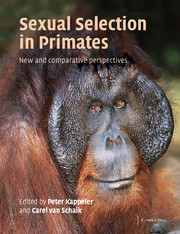Book contents
- Frontmatter
- Contents
- List of contributors
- Foreword by Robert L. Trivers
- Preface
- PART I INTRODUCTION
- PART II SEXUAL SIGNALS: SUBSTRATES AND FUNCTION
- PART III SEXUAL SELECTION IN ACTION
- PART IV DEVELOPMENT AND CONSEQUENCES
- 10 Development and sexual selection in primates
- 11 Alternative male reproductive strategies: male bimaturism in orangutans
- 12 Sexual selection and the careers of primate males: paternity concentration, dominance-acquisition tactics and transfer decisions
- 13 Sexual selection, measures of sexual selection, and sexual dimorphism in primates
- 14 Sex ratios in primate groups
- 15 Natural and sexual selection and the evolution of multi-level societies: insights from zebras with comparisons to primates
- Index
- References
10 - Development and sexual selection in primates
Published online by Cambridge University Press: 10 August 2009
- Frontmatter
- Contents
- List of contributors
- Foreword by Robert L. Trivers
- Preface
- PART I INTRODUCTION
- PART II SEXUAL SIGNALS: SUBSTRATES AND FUNCTION
- PART III SEXUAL SELECTION IN ACTION
- PART IV DEVELOPMENT AND CONSEQUENCES
- 10 Development and sexual selection in primates
- 11 Alternative male reproductive strategies: male bimaturism in orangutans
- 12 Sexual selection and the careers of primate males: paternity concentration, dominance-acquisition tactics and transfer decisions
- 13 Sexual selection, measures of sexual selection, and sexual dimorphism in primates
- 14 Sex ratios in primate groups
- 15 Natural and sexual selection and the evolution of multi-level societies: insights from zebras with comparisons to primates
- Index
- References
Summary
INTRODUCTION
Studies of sexual selection in primates or other animals tend to focus on outcomes – sexual dimorphism, differential mating and reproductive success for adult males and females. However, adult sex differences represent the end-points of complex and interrelated developmental processes, and arise from differences in behaviour and physiology between males and females. In most vertebrates, including primates, the sexes are nearly identical in size and shape during early development, and adult differences are thus the product of divergent growth strategies (Badyaev, 2002). Sex differences in growth and development arise as a result of the different roles played by the two sexes in reproduction and the corresponding determinants of reproductive success for males and females, which are intricately linked to social organisation and mating system (Kappeler & van Schaik, 2002). Evolution shapes processes throughout the lifecycle, and the mechanisms for partitioning resources among growth, reproduction and survival are, to a large part, established during development, while consequences may not be observed until the end of the lifespan. A developmental perspective is therefore fundamental to studies of the action of sexual selection (see also Pereira & Leigh, 2003).
For mammals in general, and primates in particular, past work on sexual selection and development has concentrated on the influence of growth on sexual dimorphism (e.g. ungulates: Jarman, 1983; Georgiadis, 1985; Clutton-Brock et al., 1992; seals: Trillmich, 1996; primates: Leigh, 1995; Pereira & Leigh, 2003) or growth and life-history traits such as rates of reproduction (e.g. Gordon, 1989; Pontier et al. , 1989; Lee & 2003).
Information
- Type
- Chapter
- Information
- Sexual Selection in PrimatesNew and Comparative Perspectives, pp. 175 - 195Publisher: Cambridge University PressPrint publication year: 2004
References
Accessibility standard: Unknown
- 26
- Cited by
